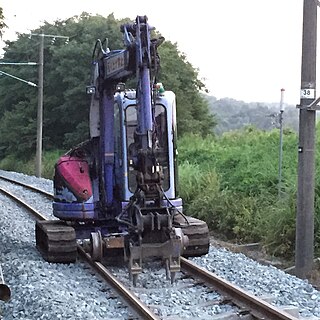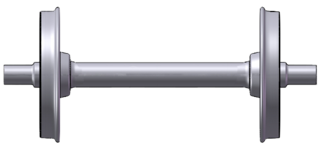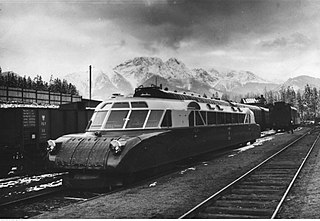
A bogie is a chassis or framework that carries a wheelset, attached to a vehicle—a modular subassembly of wheels and axles. Bogies take various forms in various modes of transport. A bogie may remain normally attached or be quickly detachable. It may include a suspension component within it, or be solid and in turn be suspended ; it may be mounted on a swivel, as traditionally on a railway carriage or locomotive, additionally jointed and sprung, or held in place by other means.

A tire or tyre is a ring-shaped component that surrounds a wheel's rim to transfer a vehicle's load from the axle through the wheel to the ground and to provide traction on the surface over which the wheel travels. Most tires, such as those for automobiles and bicycles, are pneumatically inflated structures, providing a flexible cushion that absorbs shock as the tire rolls over rough features on the surface. Tires provide a footprint, called a contact patch, designed to match the vehicle's weight and the bearing on the surface that it rolls over by exerting a pressure that will avoid deforming the surface.

A rubber-tyred metro or rubber-tired metro is a form of rapid transit system that uses a mix of road and rail technology. The vehicles have wheels with rubber tires that run on rolling pads inside guide bars for traction, as well as traditional railway steel wheels with deep flanges on steel tracks for guidance through conventional switches as well as guidance in case a tyre fails. Most rubber-tyred trains are purpose-built and designed for the system on which they operate. Guided buses are sometimes referred to as 'trams on tyres', and compared to rubber-tyred metros.

The Tünel is a historic, underground, rubber-tyred funicular line in Istanbul, Turkey. It has two stations, connecting Karaköy and Beyoğlu. The tunnel runs uphill from near the confluence of the Golden Horn with the Bosphorus and is about 573 metres long. Inaugurated on 17 January, 1875, the Tünel is the second-oldest fully underground urban railway in the world, after the London Underground (1863) and oldest in continental Europe, pre-dating the Budapest Metro by 21 years.

ACF Industries, originally the American Car and Foundry Company, is an American manufacturer of railroad rolling stock. One of its subsidiaries was once (1925–54) a manufacturer of motor coaches and trolley coaches under the brand names of (first) ACF and (later) ACF-Brill. Today, the company is known as ACF Industries LLC and is based in St. Charles, Missouri. It is owned by investor Carl Icahn.

Trojan was a British automobile manufacturer producing light cars between 1914 and 1965, and light commercial vehicles for a short time.

The Lyon Metro is a rapid transit system serving Lyon Metropolis, France. First opened in 1974, it currently consists of four lines, serving 42 stations and comprising 34.4 kilometres (21.4 mi) of route. Part of the Transports en Commun Lyonnais (TCL) system of public transport, it is supported by two funiculars and a tramway network.

The Budd Company was a 20th-century metal fabricator, a major supplier of body components to the automobile industry, and a manufacturer of stainless steel passenger rail cars, airframes, missile and space vehicles, and various defense products.

Rolling resistance, sometimes called rolling friction or rolling drag, is the force resisting the motion when a body rolls on a surface. It is mainly caused by non-elastic effects; that is, not all the energy needed for deformation of the wheel, roadbed, etc., is recovered when the pressure is removed. Two forms of this are hysteresis losses, and permanent (plastic) deformation of the object or the surface. Note that the slippage between the wheel and the surface also results in energy dissipation. Although some researchers have included this term in rolling resistance, some suggest that this dissipation term should be treated separately from rolling resistance because it is due to the applied torque to the wheel and the resultant slip between the wheel and ground, which is called slip loss or slip resistance. In addition, only the so-called slip resistance involves friction, therefore the name "rolling friction" is to an extent a misnomer.

A road–rail vehicle or a rail–road vehicle is a dual-mode vehicle which can operate both on rail tracks and roads. They are also known as two-way vehicles, hi-rail, and rail and road vehicles.

The March 2-4-0 was an experimental six-wheeled Formula One racing car built by the March Engineering company of Bicester, UK. It was constructed in late 1976 and tested in early 1977.

The Pioneer III railcar was a short/medium-distance coach designed and built by the Budd Company in 1956 with an emphasis on weight savings. A single prototype was built, but declines in rail passenger traffic resulted in a lack of orders so Budd re-designed the concept as an electric multiple unit (m.u.). Six of the EMU coach design were purchased by the Pennsylvania Railroad with the intention of using them as a high-speed self-contained coach that could be used for long-distance commuter or short-distance intercity travel in the Northeast U.S. The 6 production Pioneer III units were the first all-stainless-steel-bodied EMU railcar built in North America and, at 90,000 pounds (41,000 kg), the lightest.

A wheelset is a pair of railroad vehicle wheels mounted rigidly on an axle such that both wheels rotate in unison. Wheelsets are often mounted in a bogie – a pivoted frame assembly holding at least two wheelsets – at each end of the vehicle. Most modern freight cars and passenger cars have bogies each with two wheelsets, but three wheelsets are used in bogies of freight cars that carry heavy loads, and three-wheelset bogies are under some passenger cars. Four-wheeled goods wagons that were once near-universal in Europe and Great Britain and their colonies have only two wheelsets; in recent decades such vehicles have become less common as trainloads have become heavier.

Luxtorpeda – a popular name of the famous Polish railcar from the 1930s.

A motorcycle tyre is the outer part of motorcycle wheel, attached to the rim, providing traction, resisting wear, absorbing surface irregularities, and allowing the motorcycle to turn via countersteering. The two tyres' contact patches are the motorcycle's connection to the ground, and so are fundamental to the motorcycle's suspension behaviour, and critically affect safety, braking, fuel economy, noise, and rider comfort.

The MP 05 is a rubber-tyred electric multiple unit with driverless operation ordered by the RATP in 2005 for the Paris Métro. The original 49 units were designed to allow the older MP 89s on line 1 to transfer to line 4 in order to automate the line. An additional fleet of 18 MP 05s was ordered for deployment on the line 14 by 2017 in order to improve service frequencies and to prepare for the line's northern extension towards Mairie de Saint-Ouen, as well as provide service enhancements to Line 1. The trainsets were constructed by Alstom.

National Steel Car is the largest manufacturer of railway rolling stock in Canada, based in Hamilton, Ontario. The company was founded in 1912, and has been a top 3 rolling stock manufacturer in Canada for its lifetime. National Steel Car is a subsidiary of National Industries Inc. and is currently led by Greg Aziz, chairman and CEO of National Steel Car.

A train wheel or rail wheel is a type of wheel specially designed for use on railway tracks. The wheel acts as a rolling component, typically press fitted onto an axle and mounted directly on a railway carriage or locomotive, or indirectly on a bogie, also called a truck. The powered wheels under the locomotive are called driving wheels. Wheels are initially cast or forged and then heat-treated to have a specific hardness. New wheels are machined using a lathe to a standardized shape, called a profile, before being installed onto an axle. All wheel profiles are regularly checked to ensure proper interaction between the wheel and the rail. Incorrectly profiled wheels and worn wheels can increase rolling resistance, reduce energy efficiency and may even cause a derailment. The International Union of Railways has defined a standard wheel diameter of 920 mm (36 in), although smaller sizes are used in some rapid transit railway systems and on ro-ro carriages.

The Budd–Michelin rubber-tired rail cars were built by the Budd Company in the United States between 1931 and 1933 using French firm Michelin's "Micheline" rail car design. Michelin built its first rail car in 1929, and by 1932 had built a fleet of nine cars that all featured innovative and distinctive pneumatic tires. In September 1931, an agreement signed between the two companies allowed Budd to use the new rubber rail tires on its shot-welded, stainless-steel carbodies, and at the same time allowed Michelin to expand into the American market.




















